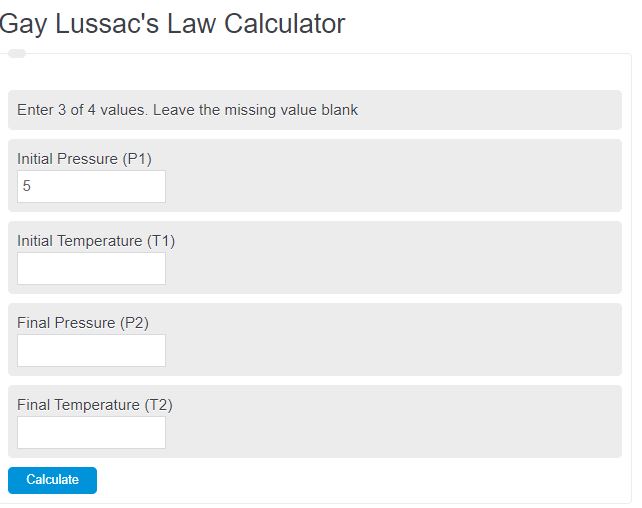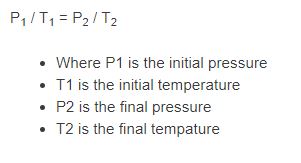Enter any 3 values of the initial and final temperatures and pressures of an ideal gas to calculate the missing value using Gay-Lussac’s Law.
Gay-Lussac’s Law Formula
The following formula describes the relations between temperature and pressure in an ideal gas.
P1 / T1 = P2 / T2
- Where P1 is the initial pressure
- T1 is the initial temperature
- P2 is the final pressure
- T2 is the final tempature
Guy-Lussac’s Law Definition
Guy-Lussac’s Law states that the pressure of a gas is directly proportional to its temperature, assuming a constant volume and amount of gas.
This law is important because it helps us understand the relationship between pressure and temperature in a gas, allowing us to make predictions and calculations in various scientific and practical applications, such as in the design of engines, weather forecasting, and gas storage.
Guy-Lussac’s Law Example
Let’s look at an example of how to calculate one of the missing values using Gay-Lussac’s Law. Let’s assume we know the initial temperature (5K), final pressure (5Pa), and final temperature (10K). To calculate the initial pressure we must rearrange the equation above to solve for P1. So, P1 = (P2/T2) * T1 = 5/5 * 10 = 10 Pa.
FAQ
How does Guy-Lussac’s Law apply to everyday life?
Guy-Lussac’s Law has practical applications in everyday life, including in the operation of pressure cookers, air conditioning systems, and the understanding of weather patterns. For example, as the temperature of the air inside a balloon increases, the pressure also increases, which is why balloons expand on hot days.
Can Guy-Lussac’s Law be used for all gases?
While Guy-Lussac’s Law applies to ideal gases, it can also be used as a good approximation for real gases under a wide range of conditions, except when the gas is at very high pressure or low temperature where deviations from ideal behavior are observed.
What happens if the volume or the amount of gas changes?
Guy-Lussac’s Law assumes that the volume and the amount of gas are held constant. If either the volume or the amount of gas changes, other gas laws, such as Boyle’s Law (for volume changes at constant temperature) or the Combined Gas Law, might be more applicable.
Why is Guy-Lussac’s Law important in scientific research?
Guy-Lussac’s Law is crucial in scientific research for understanding and predicting the behavior of gases under different temperatures. It’s used in chemistry and physics to solve problems related to gas reactions, engine efficiency, atmospheric studies, and even in the design of safety mechanisms for gas storage and transport.

